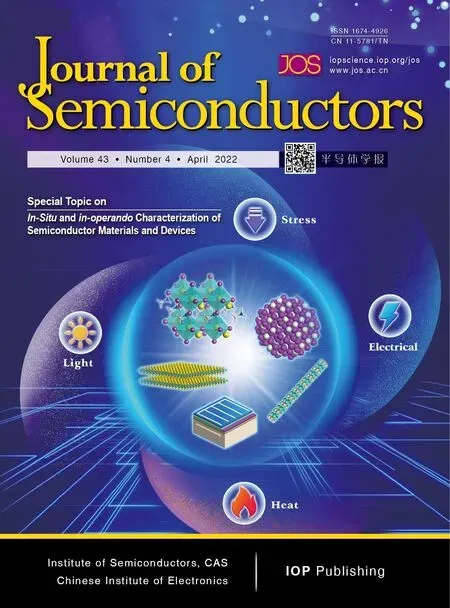Stabilizing α-phase FAPbI3 solar cells
2023-01-05YaxinWangXinZhangZejiaoShiLixiuZhangAnranYuYiqiangZhanandLimingDing
Yaxin Wang, Xin Zhang, , Zejiao Shi, Lixiu Zhang, Anran Yu, , Yiqiang Zhan, , and Liming Ding,
1Center for Micro-Nano Systems, School of Information Science and Technology, Fudan University, Shanghai 200433, China
2Academy for Engineering & Technology, Fudan University, Shanghai 200433, China
3Center for Excellence in Nanoscience (CAS), Key Laboratory of Nanosystem and Hierarchical Fabrication (CAS), National Center for Nanoscience and Technology, Beijing 100190, China
Organic–inorganic hybrid perovskite solar cells (PSCs)have been recognized as a promising and cost-effective photovoltaic technology with the power conversion efficiency(PCE) exceeding 25%[1–3]. The high efficiency is attributed to the exceptional optoelectronic properties, such as high absorption coefficient, long carrier diffusion length, low non-radiative recombination rate, and so on[4–7]. Compared to methylammonium lead triiodide (MAPbI3) perovskite, formamidinium lead triiodide (FAPbI3) perovskite exhibits better thermal and structural stability. Meanwhile, it has a narrower bandgap,which is close to the optimum bandgap for reaching Shockley-Queisser limit (Fig. 1(a))[8]. So, FAPbI3is an ideal candidate for highly efficient single-junction PSCs. However, the black photoactive α-FAPbI3formed at high temperature(~150 °C) can readily convert to photoinactive δ-FAPbI3under ambient conditions[9–11], which is fatal to device performance and stability. Therefore, various approaches have been proposed to overcome the phase transition. Here, we will discuss three strategies: chloride-based additives, pseudo-halide anion engineering and ionic liquid engineering.
Chloride-based additives play an important role in improving the phase stability and crystallinity. The pioneer work was reported by Ding’s group in 2014. They applied ammonium chloride (NH4Cl) as the additive in perovskite precursor solution to manipulate the film morphology. An 80.11% FF was obtained[12]. Wang et al. indicated that less volatile additives such as formamidinium chloride (FACl) and methylammonium chloride (MACl) in precursor solution can form an intermediate phase to prohibit the crystallization of δ-FAPbI3, which then converts to α-FAPbI3through thermal annealing[13]. Mu et al. reported that MACl acts as a transitional “stabilizer” to preserve the crystal structure and form black-phase FAPbI3[14]. Xie et al. proposed a new “vertical recrystallization”method by using MACl additive to make FA-based perovskite films with high crystallinity, yielding a PCE of 20.6%[15]. Qing et al. described the synergistic effects of DMSO and MACl in assisting perovskite crystallization, leading to smoother surface, higher crystallinity, and lower defect densities[16]. Kim et al. studied the function of MACl additive in the formation of α-phase FAPbI3via analyzing the photophysical properties and using density functional theory. By optimizing MACl content, they achieved a certified PCE of 23.48% (Fig. 1(b))[17]. Min et al. further stabilized α-FAPbI3by incorporating methylenediammonium dichloride (MDACl2) into FAPbI3perovskite lattices, obtaining a certified PCE of 23.7%[18].
Pseudo halides can also improve perovskite crystallinity and phase stability, due to their similar properties as halides.Thiocyanate anion (SCN−), one of the pseudo halide anions,has received attention during past few years[19]. Lu et al. used a methylammonium thiocyanate (MASCN) vapor-assisted treatment to convert δ-FAPbI3to pure α-FAPbI3, which was carried out below the thermodynamic phase-transition temperature. Molecular dynamics (MD) simulations revealed that SCN–can promote the formation and stabilization of α-FAPbI3. The resulted PSCs presented excellent performance and longterm operational stability (Fig. 1(c))[11]. Jeong et al. indicated that formate (HCOO−) can suppress anion-vacancy defects at grain boundaries and perovskite film surface. By using formate additive, α-FAPbI3PSCs offered a PCE of 25.6% (certified 25.2%)[3].
Ionic liquid engineering is also an effective approach to stabilize black α-FAPbI3. DMF and DMSO are usually used in combination to retard perovskite crystallization, and the experiment was processed in an inert atmosphere with strict control of both temperature and humidity[20]. Hui et al. used ionic liquid methylamine formate (MAFa) to replace DMF:DMSO as solvent of PbI2in the two-step deposition. The strong interactions with PbI2through C=O·Pb chelation and N–H··I hydrogen bonds promote the vertical growth of PbI2, forming nanoscale channels to facilitate the penetration of FAI into PbI2film. This enables rapid conversion to α-FAPbI3regardless of humidity and temperature. A PCE of 24.1% was achieved(Fig. 1(d))[21].
In summary, many efforts have been put into making pure α-FAPbI3solar cells, and the phase stability and longterm operational stability should be further improved. Understanding the phase transition and optimizing the fabrication methods will further enhance the performance and stability of PSCs for commercialization.
Acknowledgements
This work was supported by the National Natural Science Foundation of China (61774046). L. Ding thanks the National Key Research and Development Program of China(2017YFA0206600) and the National Natural Science Foundation of China (51773045, 21772030, 51922032, and 21961160720) for financial support.
杂志排行
Journal of Semiconductors的其它文章
- Preface to the Special Topic on In-Situ and in-operando Characterization of Semiconductor Materials and Devices
- Janus VXY monolayers with tunable large Berry curvature
- DASP: Defect and Dopant ab-initio Simulation Package
- Recent progress on advanced transmission electron microscopy characterization for halide perovskite semiconductors
- Structural evolution of low-dimensional metal oxide semiconductors under external stress
- In-situ monitoring of dynamic behavior of catalyst materials and reaction intermediates in semiconductor catalytic processes
